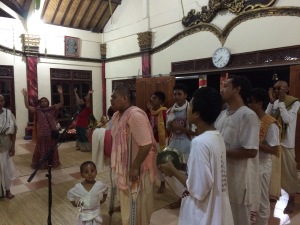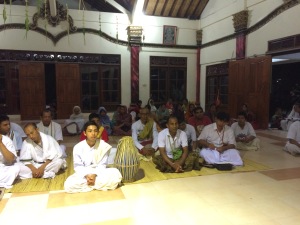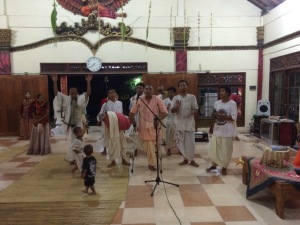HG Visvambhara Prabhu / SB 10.72.11
Why does Gita 7.25 use yoga-maya instead of maha-maya?
→ The Spiritual Scientist
From Keshava Kashmiri P
Srila prabhupada have many times stated the difference between mahamaya and yogamaya in his purports . but this specific verse of bhagavad gita talks about ,how lord krishna covers his identity from the people who are not devotees (as stated “fools and unintelligent ” ) then why krishna uses a word yogamaya ,and not mahamaya . By yogamaya potency ,krishna’s devotees like gopis ,arjuna ,mother yashoda ,krishna hideS his identity of being supreme lord ,so that he can relish the sweetness of his devotees love in various rasa . whereas mahamaya is specifically used to bewilder atheist and faithless .then wouldn’t it be more appropriate ,if verse 7.25 would have talked about mahamaya
PLEASE EXPLAIN .
Does the Gita ask Arjuna to choose job over family?
→ The Spiritual Scientist
The Gita asks Arjuna to choose his kshatriya-dharma (his job) over his kula-dharma (his family duty). So isn't it anti-family?
Should prostitution be legalized in India?
→ The Spiritual Scientist
The National Woman's Commission and the Indian Government are considering this. What is the Vedic perspective on it?
Gita 03.16 – Absorption in higher things that connects us with the highest reality brings the highest happiness
→ The Spiritual Scientist
The Matrix of Illusion
→ Bhakti Lounge - The Heart Of Yoga in Wellington
New workshop series!
Come take part in intriguing and structured group discussion evenings hosted by Mahavan, who has been practising and teaching the knowledge of Bhakti-Yoga for over 15 years. Mahavan is also a photographer, a musician and manager of a Vedic contemporary mens ashram. All welcome, beginners and everyone!
Price includes yoga & amazing vegetarian dinner.
Take up the challenge!
→ KKSBlog
(Kadamba Kanana Swami, 29 October 2014, Vrindavan, India, Srimad Bhagavatam 5.13.22)
 Kunti Devi is explaining that one must be materially exhausted and take no more pride in the position of one’s birth, wealth, learning or beauty. However, it is very challenging to overcome tendencies of taking pride in those things. On Srila Prabhupada’s disappearance day, I was allowed to speak for a few minutes. I had a point in my mind that Srila Prabhupada was the most challenging personality the world has ever seen; no one ever challenged world more than he did. He challenged in all kind of ways.
Kunti Devi is explaining that one must be materially exhausted and take no more pride in the position of one’s birth, wealth, learning or beauty. However, it is very challenging to overcome tendencies of taking pride in those things. On Srila Prabhupada’s disappearance day, I was allowed to speak for a few minutes. I had a point in my mind that Srila Prabhupada was the most challenging personality the world has ever seen; no one ever challenged world more than he did. He challenged in all kind of ways.
First of all, he challenged the world by his presence, just by being who he was, by being such an unalloyed pure devotee, so totally selfless – by being ready to do anything and everything to spread Krsna consciousness to a point that is just mind blowing!
Furthermore, he challenged the world by his teachings that were completely uncompromised – four regulative principles, minimum sixteen rounds – so challenging for us as we have to do it every day. Every moment in our life, we seem to be challenged and in that challenge, we know very well that we are falling short… We know that maybe externally we are his follower but internally how much are we truly? We recognize that we want, to a certain extent, a comfortable position and some recognition – some janma, some aisvarya, some sruta, some sribhir – some recognition for who we are, for what we have, for what we know; and we consider ourselves very handsome, aristocratic and beautiful. So, we are challenged! And when we become dull headed, then that challenge just does not touch us as we become complacent and simply do not care.
There are extreme examples, like in this temple in the past, there was one devotee who had a bead bag but we found out that there were no beads inside! That is kind of missing the point, isn’t it? But even if we may have beads – are we really chanting or are we counting our rounds? To what extent are we really taking things to our heart or are we just dull headed? Our dull headedness, our inner resistance, is due to the mode of ignorance. It is due to our unwillingness and stubbornness that we do not want to follow; it is due to pride that covers us over. So, this dull headedness is a serious problem.
Still, Srila Prabhupada says that arguments offered by pure devotees to their disciples are so convincing that even a dull headed disciple is immediately enlightened with spiritual knowledge. It is a fact – in this movement, it is difficult to just go on automatic pilot and not be confronted with our own shortcomings, because again and again, we hear it and read about it. We are confronted by that theme that returns again and again that we should do better – wake up calls are coming so many times.
 So we should ourselves take the medicine. Why wait for someone else to bring it to us, why wait for someone to bring and say, ‘Take your pills?’ In other words, we ourselves have to turn to the pure devotee. Nowadays, everything is so widely available electronically. To have some lectures of Srila Prabhupada or any vaisnava on our phone is very easy, but to push that button, to turn it on, seems to be very difficult! But we must make that effort, to go all the way and lift the hand and push the button. Oh, it is very painful for the finger to push! But that much effort has to be made. And that is where our dullness tends to interfere. We feel, ‘Too much trouble – my phone is all the way on the other side of the room! Too difficult!’ No time, no this, no that!
So we should ourselves take the medicine. Why wait for someone else to bring it to us, why wait for someone to bring and say, ‘Take your pills?’ In other words, we ourselves have to turn to the pure devotee. Nowadays, everything is so widely available electronically. To have some lectures of Srila Prabhupada or any vaisnava on our phone is very easy, but to push that button, to turn it on, seems to be very difficult! But we must make that effort, to go all the way and lift the hand and push the button. Oh, it is very painful for the finger to push! But that much effort has to be made. And that is where our dullness tends to interfere. We feel, ‘Too much trouble – my phone is all the way on the other side of the room! Too difficult!’ No time, no this, no that!
So what we need in our life is a culture of cultivation of Krsna consciousness. That is what Srila Rupa Gosvami had explained, krsnanusilanam, that we must cultivate our Krsna consciousness. A regular practice or cultivation of Krsna consciousness is also what Krsna mentions in Bhagavad-gita (8.8), abhyasa yoga-yuktena cetasa anya-gamina. It does not just come by hearing once – we are too dull – we have to hear it a hundred times and if we hear it a thousand times then maybe we will think, ‘Well, maybe I should actually also do this. Somehow or other, I got this idea that maybe I should follow this.’ That is what it takes before we are actually ready to act upon it. So let us hear about Krsna!
Where do they take Srila Prabhupadas books like hot…
→ Dandavats.com

Where do they take Srila Prabhupadas books like hot cakes?
(Album 71 photos)
Mexico, for sure this is one of best places for spreading Yuga Dharma Harinam Sankirtan. People here are very open and taking Mahaprabhus mercy with full enthusiasm. They are taking Srila Prabhupadas books like hot cakes and are opening them to read on the spot. We are very thankful to all the kind hearted devotees here who helped us spread the Holy Name in Mexico.
http://goo.gl/sgGSso
Bhagavatam-daily 35 – 11.07.25 – Renunciation comes not from frustration but from illumination
→ The Spiritual Scientist
HG Narottamananda Prabhu / BG 4.30 & Kirtan
→ Kalachandji's Audio Archive
HG Narottamananda Prabhu / SB 10.72.8-10
→ Kalachandji's Audio Archive
HG Narottamananda Prabhu / Kalachandji’s Bhagavad-Gītā Meditation Course – 38
→ Kalachandji's Audio Archive
Please Join The Japa Group
→ Japa Group
The Art of Devotion
In the artistic traditions of India, which…
→ Dandavats.com

The Art of Devotion
In the artistic traditions of India, which are rooted in its spiritual heritage, a devotee of Krishna finds inspiration for her spiritual practices. ” . I worship that transcendental seat, known as Svetadvipa … where every word is a song, every gait is a dance, and the flute is the favorite attendant.” . (Sri Brahma-samhita 5.56) What is the purpose of art? In art college I learned that it is a way to express something about oneself, something original. Fair comments, but what about the point of it all? What should be the reason for a work of art, a dance, or a piece of music? For many, it is the creation itself, or even the desire for the fame that comes with making something never created before.
http://goo.gl/A6hjVl
I Lost My Heart in Vrindavana!
The first time I entered the…
→ Dandavats.com

I Lost My Heart in Vrindavana!
The first time I entered the ISKCON temple in Mumbai – it was in February 2012 something caught my attention, besides, of course, the Deities and the beautiful architecture inside: I noticed many devotees wearing T-shirts carrying the slogan “I Lost My Heart in Vrindavana.” What’s so special about Vrindavana? I wondered. I had some faint idea about this place – how it was related to Lord Krishna’ s childhood activities – but nothing much.
After beginning to associate with devotees, I started to realize how this place is extremely special. Visiting such holy places, I learned, is an integral part of devotional service, and so devotees made regular pilgrimages to Vrindavana and meditated on its glories. Rupa Goswami, the sixteenth-century saint of medieval India, has described in his writings the exalted position of Vrindavana and the immense spiritual benefit one can derive by staying there. I hoped and prayed that I too would get an opportunity to go to Vrindavana.
http://goo.gl/y1hgJ9
Varnasrama series 2
→ SivaramaSwami.com
Why without being fixed in a bhakti-friendly social structure devotees will struggle to perfect themselves.
The post Varnasrama series 2 appeared first on SivaramaSwami.com.
Harinama in a wintery Moscow, Russia (Album 65 photos)
When the…
→ Dandavats.com

Harinama in a wintery Moscow, Russia (Album 65 photos)
When the Hare Krishna mantra is chanted by many men together, it is called sankirtana, and as a result of such a yajna there will be clouds in the sky (yajnad bhavati parjanyah [Bg.2.14]). In these days of drought, people can gain relief from scarcity of rain and food by the simple method of the Hare Krishna yajna. (Srimad-Bhagavatam, 9.1.17 Purport)
http://goo.gl/itrtWP
ISKCON Czech Republic – Indian festival in Pilsen, Czech…
→ Dandavats.com

ISKCON Czech Republic - Indian festival in Pilsen, Czech Republic
18 November 2014 (Album 26 photos)
Visit rate: 180 people. The special guest: HH Danavir Goswami
http://goo.gl/cCyXZU
New Vrindaban’s Transcendental Throwback Thursday – 11/20/2014
→ New Vrindaban Brijabasi Spirit
This week’s challenge: Many people will be enlivened to know the building in this photo is currently undergoing a major renaissance. Can you identify it, what purposes it’s served over the years, and possibly the era this photo was taken?
Extra credit: Can you ID any of the Matajis in the foreground?
What to do: Post your guesses on the “who, what, when, where & why” in the comment section at the Brijabasi Spirit website.
On a Thursday night
→ Krishna Lounge
What are the consequences of sin?
→ The Spiritual Scientist
Why is every sin ultimately a sin against God?
→ The Spiritual Scientist
What does it mean to be free from sin?
→ The Spiritual Scientist
What does it mean to be a slave to sin?
→ The Spiritual Scientist
How can I overcome a habitual sin?
→ The Spiritual Scientist
Ratha-yatra, November 16, Laguna Beach
Giriraj Swami
 “During the Ratha-yatra festival, Lord caitanya manifested the mood of Radharani wanting to bring Krishna back to Vrindavan. He would pull the chariot and that emotional process was pulling Krishna back to Vrindavan. In a way we want to install Krishna in our hearts. This body is compared to a chariot, so just as Lord Jagannatha was placed on a chariot at Ratha-yatra, we also want to place Lord Jagannatha or Krishna on the chariot of our hearts. But, in order to do that we have to cleanse our hearts.”
“During the Ratha-yatra festival, Lord caitanya manifested the mood of Radharani wanting to bring Krishna back to Vrindavan. He would pull the chariot and that emotional process was pulling Krishna back to Vrindavan. In a way we want to install Krishna in our hearts. This body is compared to a chariot, so just as Lord Jagannatha was placed on a chariot at Ratha-yatra, we also want to place Lord Jagannatha or Krishna on the chariot of our hearts. But, in order to do that we have to cleanse our hearts.”
True Authority, According to Śrī Jīva Gosvāmī
→ The Enquirer
This is a translation of Tattva-sandarbha 10 & 11, with “my” comments inset. Please think about the implications of excluding “Statements of Scholars” and “Tradition” from śabdha-pramāṇa and the significance this has on 95% of what is most often spoken on contemporary disscussions of śāstra (like Bhāgavatam classes or public lectures).
People have four flaws, beginning with misperception.
Therefore, our ability to ascertain the veracity of anything is limited, particularly in regard to things of a spiritual nature which are, by their very nature, beyond the boundaries of normal perception. For that we certainly require assistance from the uncommon words of the Veda.
1) Empirical perception (pratyakṣa)
2) Logical deduction (anumāna)
3) Expert instruction (śabda)
“Empirical perception” involves many forms of direct measurement (pratyakṣa) as well as indirect observation of the remote effect one entity exerts upon another (ceṣṭā).
“Logical deduction” involves many forms of extrapolation. Some examples are comparisons (upamāna), probabilities (arthāpatti), inferences (abhāva), and inclusions (sambhava).
“Expert instruction” means to receive valid information from someone who is an expert authority on a subject. However, this does not deserve to be a separate category unless the expert authority ascertains veracity on the basis of something other than empirical perception or logical deduction. For example, statements of scholars (ārṣa) seem like “expert instruction,” but it is relegated to Perception or Deduction if the scholars base their instruction primarily on their own empiricism or logic. Tradition (aitihya) is similar. Many people may accept an idea for a very long time, but this sort of authority is differentiated from “expert instruction” and relegated to the other two categories if the source of the tradition is someone’s perception or deduction.
If “expert instruction” does not originate from empirical observation or logical deduction, where does it originate? Śrī Jīva explains…
The beginningless and perfect words of the Veda are self-manifest and communicated to all people through paramparā.
“Logic and argument cannot prove or disprove transcendent things.”
— Vedānta Sūtra 2.1.11
“Argument is not capable of determining things that are beyond comprehension.”
— Mahābhārata Bhīṣma.5.22
“Such knowledge is born from Śāstra.”
— Vedānta Sūtra 1.1.3
“The Śruti is the ultimate root of the veracity of all concepts.”
— Vedānta Sūtra 2.1.27
“The Veda is the only eye through which anyone — human, ancestor, or god — can see the Supreme and come to understand the ultimate objective and means.”
— Śrīmad Bhāgavatam 11.20.4
Krsna’s Name Is Personal
→ Japa Group
A Day at Sri Mayapur International School
→ ISKCON News
Narendra Modi Calls for International Yoga Day
→ ISKCON News
ISKCON 50th Anniversary Gratitude Coin Announcement
→ ISKCON News

In order to celebrate the 50th anniversary of ISKCON, as well as to show our combined gratitude to its Founder/Acharya for this wonderful, transcendental gift he has given to us, the TOVP Fundraising Team has created a special Gratitude Coin Program for those who are able to offer a large amount of financial support.
Window Shopping
→ ISKCON News
Coal Rush in India Could Tip Balance on Climate Change
→ ISKCON News
New Album from Mandali
→ ISKCON News
Ekadasi at Radha Gopinath Mandir
→ Ramai Swami
On every Ekadasi, many devotees from Radha Gopinath Mandir, Bali, gather at the temple.
Bhagavatam-daily 34 – 11.07.24 – Learning from the past is a shortcut to learning
→ The Spiritual Scientist
Famous Indian Cricketer Parthiv Patel receives Bhagavad…
→ Dandavats.com

Famous Indian Cricketer Parthiv Patel receives Bhagavad Gita
Even a faint light from the holy name of the Lord can eradicate all the reactions of sinful life. (Sri Caitanya-caritamrta, Antya-lila, 3.63)
In remembrance of the disappearance of Sri Saranga Thakura, which is celebrated tomorrow
→ SivaramaSwami.com
The post In remembrance of the disappearance of Sri Saranga Thakura, which is celebrated tomorrow appeared first on SivaramaSwami.com.












